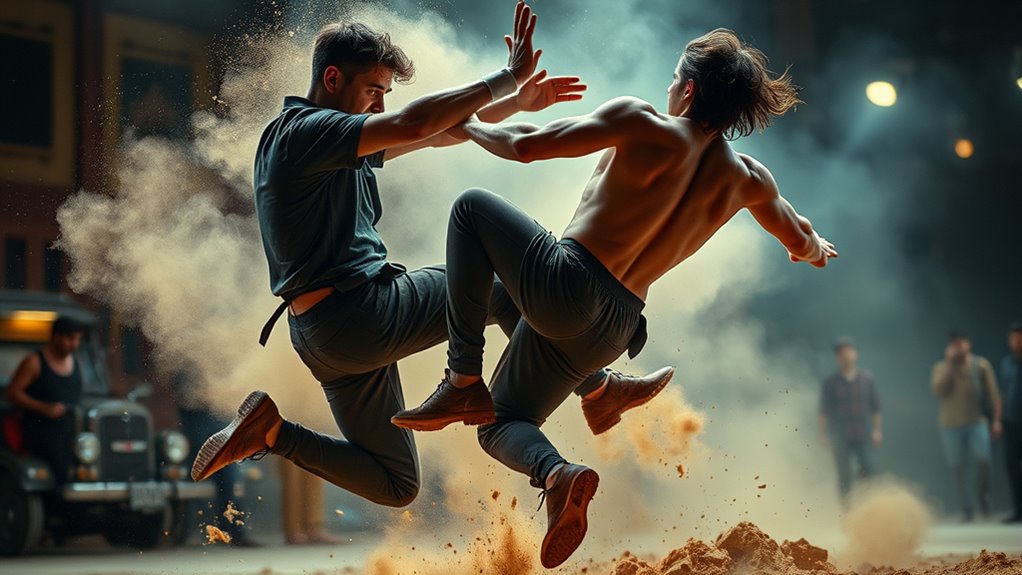When choreographing fight scenes for trailer moments, focus on key shots like slow motion, close-ups, and quick cuts to maximize impact. Plan carefully by rehearsing repeatedly to refine timing, ensuring movements look natural and emotionally charged. Collaborate closely with stunt coordinators to balance safety with visual spectacle. Incorporate innovative techniques and camera angles to heighten excitement. Keep in mind that every movement should serve storytelling; if you want to master this craft, there’s more to discover ahead.
Key Takeaways
- Focus on key moments like slow-motion, close-ups, and quick cuts to highlight choreography and enhance emotional impact.
- Collaborate closely with stunt coordinators to ensure safety while maintaining visual authenticity.
- Rehearse repeatedly to refine timing, fluidity, and organic movement that serve storytelling.
- Incorporate innovative techniques such as weapon work or unconventional styles for visual interest.
- Plan camera angles and effects strategically to maximize spectacle and emotional engagement.

Creating compelling fight scenes requires more than just staging punches and kicks; it demands careful choreography that combines storytelling with physical action. When you’re choreographing fight scenes for trailer moments, every move must serve a purpose—driving the story forward and capturing the audience’s attention in a matter of seconds. Your goal is to craft sequences that are visually striking yet believable, blending fight choreography with stunt coordination to achieve seamless, high-impact moments. It’s about balancing realism with spectacle, so the audience feels the intensity without losing sight of the narrative context.
Effective fight scenes blend storytelling with choreography, balancing realism and spectacle for maximum impact.
Fight choreography is the backbone of any memorable fight scene. You need to think beyond just hitting targets; it’s about creating a rhythm and flow that enhance the emotional stakes. As you plan each move, consider the characters’ personalities, motivations, and the story beats they’re hitting. Every punch, kick, and block should reflect who they are and what they’re fighting for. Working closely with stunt coordinators is essential here—they bring expertise in timing, safety, and practical effects, ensuring that your choreography looks dynamic while minimizing risks. Stunt coordination is not just about executing dangerous moves; it’s about making them look effortless and natural, so the audience buys into the illusion.
When designing fight scenes for trailers, you want to maximize impact within a limited timeframe. This means focusing on key moments—slow-motion shots, close-ups, and quick cuts—that highlight the choreography and stunt work. You should plan these moments carefully, ensuring they’re visually compelling and emotionally charged. This involves rehearsing repeatedly to refine timing and precision, so each move lands perfectly on cue. The choreography should feel organic, not stiff or overly rehearsed, which is where stunt coordination plays a crucial role in coordinating camera angles, wire work, and safety measures to enhance the authenticity.
Finally, remember that fight scenes for trailers often serve as a visual hook. They’re designed to excite and intrigue viewers, so don’t be afraid to push the boundaries of creativity. Incorporate innovative techniques—like unique weapon work or unconventional fighting styles—while maintaining clarity and coherence. Throughout the process, communication is key; you need to work hand-in-hand with stunt coordinators to ensure your vision is executed safely and effectively. When all elements come together—storytelling, fight choreography, and stunt coordination—you’ll create trailer moments that are not only thrilling but also memorable, leaving audiences eager to see the full story unfold.
Frequently Asked Questions
How Do Fight Scenes Enhance Trailer Storytelling?
Fight scenes boost trailer storytelling by creating intense, memorable moments that grab viewers’ attention. You use stunt coordination to craft dynamic, believable action that supports the story’s emotional beats. These scenes visually communicate conflict, character strength, or vulnerability, making the trailer more engaging. Well-choreographed fights add excitement and help viewers quickly understand the stakes, making them enthusiastic to see the full story unfold.
What Safety Measures Are Essential During Fight Choreography?
Thinking about safety during fight choreography is like building a sturdy bridge—you need solid support. You should follow strict safety protocols and work closely with stunt coordination experts. Always plan movements carefully, use protective gear, and rehearse thoroughly to prevent accidents. Clear communication and understanding of each performer’s limits are key. By prioritizing these safety measures, you guarantee everyone stays safe while creating dynamic, exciting fight scenes.
How Do You Choose Fight Locations for Trailers?
When choosing fight locations for trailers, you focus on stunt coordination and location scouting to find the perfect backdrop. You consider space for safe choreography, accessibility for equipment and crew, and the visual impact of the setting. You also evaluate the environment’s safety features and permissions needed. By scouting thoroughly, you guarantee the location enhances the scene’s intensity while keeping everyone safe during the shoot.
What Role Does Music Play in Fight Scene Choreography?
Imagine you’re designing a fight scene where the choreography rhythm syncs perfectly with a tense, pulsating soundtrack. Music plays an essential role by influencing your pacing, enhancing emotional impact through music psychology. It guides your choreography choices, making movements feel more intense or fluid. For instance, a rapid beat can inspire quick, sharp strikes, ensuring the scene’s energy aligns seamlessly with the music, heightening audience engagement and drama.
How Can CGI Enhance Fight Scenes in Trailers?
You can enhance fight scenes in trailers with CGI by seamlessly integrating visual effects that amplify your choreography. Use CGI to add dynamic elements, like explosions or energy blasts, without risking safety. Combining CGI with stunt coordination helps you craft more dramatic, intense moments that captivate viewers. This synergy makes your fight scenes more visually stunning, immersive, and memorable, elevating the overall impact of your trailer.
Conclusion
Remember, a well-choreographed fight scene can make or break your trailer. You have the power to create moments that captivate and thrill your audience, so pay attention to detail and timing. Don’t forget, “practice makes perfect,” and the more you refine your choreography, the more authentic it will feel. Trust your instincts, stay creative, and keep pushing boundaries—you’re shaping unforgettable moments that will leave viewers on the edge of their seats.









